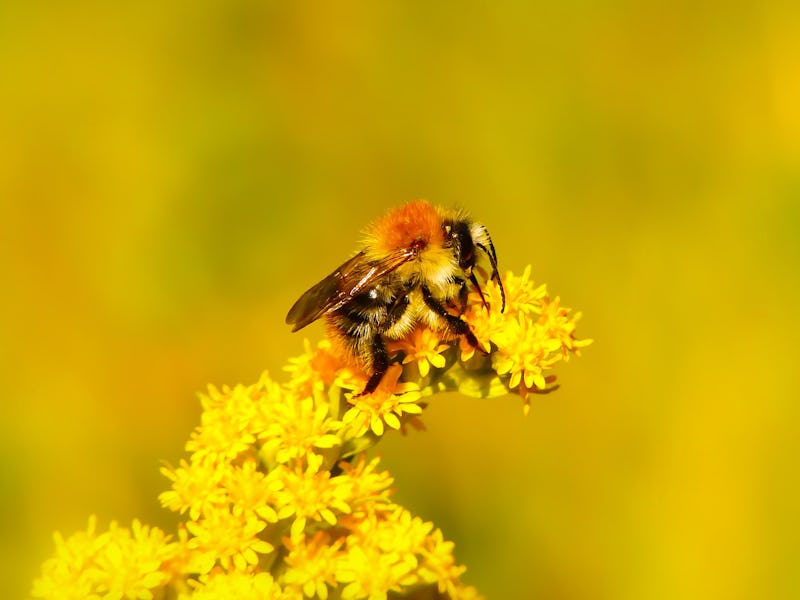Why Flowers May Be Partially to Blame for the Deaths of Wild Bumblebees
"We wanted to test this widely stated but largely untested hypothesis."

Imagine picking up a half-empty soda on the sidewalk and taking a big sip. You have no idea what you’d be exposing yourself to. But this is basically what wild bumblebees do when they flit from flower to flower, sipping nectar that other bees have slurped. Pure as flower-feeding bees may seem, research published Wednesday in PLOS One reveals that those same flowers might actually be playing a role in the demise of wild bees.
"We wanted to test this widely stated but largely untested hypothesis."
In the paper, researchers report that managed honeybees (Apis mellifera) seem to be spreading diseases to wild bumblebees (Bombus spp.) through the flowers that both bees feed on. Those flowers appear to be harboring RNA viruses, including deformed wing virus (DWV) and black queen cell virus, (BQCV) which are most often associated with managed honeybees.
The team realized that when honeybees weren’t foraging from the same flowers as wild bumblebees, there were no cases of DWV in the bumblebees. They also saw that BQCV cases were more common when bumblebees foraged near human-managed beehives called apiaries.
The researchers were led by Samantha Alger, Ph.D., who completed the work as a Ph.D. student at the University of Vermont while studying declining bumblebee populations and the factors driving the decline. Some researchers, she explains to Inverse, had suspected that viruses were spilling over from honeybees, while others hypothesized that diseases were just circulating among pollinator insects in general.
“But there wasn’t much evidence supporting these hypotheses,” she says. “We wanted to test this widely stated but largely untested hypothesis.”
Bumblebees may be susceptible to diseases carried by managed hives of honeybees.
To test this idea, they collected bumblebees, honeybees, and flowering plants from 19 different sites — seven that were within 300 meters (about 1,000 feet) of apiaries, and 12 that were at least a kilometer (about 0.6 miles) away from any apiaries. Then they tested them for viruses.
“We detected BQCV in 75.7% and DWV in 9.3% of bumblebees tested,” they write. For honeybees, 100 percent of them tested positive for both viruses, with varying loads.
Most importantly, they saw that levels of both viruses were significantly higher in the bumblebees that were collected closer to apiaries.
As a result of these findings, Alger has gotten involved with several organized efforts to track disease spread and help educate beekeepers about diseases.
“I spearheaded Vermont’s involvement with the National Honey Bee Survey, and as a result, we have started collecting standardized data on managed bee disease,” she says. “I also teach a beekeeping course at UVM to help educate new beekeepers on being good stewards of their bees. If we can reduce pathogen loads in managed honey bees, we can hopefully reduce the likelihood of spillover.”
Managed honeybee hives are hotbeds for viruses, and while these diseases are spreading to wild bumblebees, it's not clear what effect this spread is having.
Alger is careful to note that even though the spillover from managed populations is concerning, it’s still not totally clear what role, if any, these honeybee diseases are playing in bumblebee declines.
“We don’t really know how viruses affect bumblebees — there’s been very few studies on this topic,” she explains. “It’s definitely concerning that we see high prevalence of viruses in bumblebees and this is linked to honeybee presence, but we don’t know how or if viruses might be contributing to bumblebee declines.”
In the meantime, there are still clear steps that can be taken to help prevent viruses from proliferating in managed beehives — which would hopefully help slow their spread to wild bees.
“At this point, there isn’t a cure or treatment for viruses,” says Alger. “However, since varroa mites vector viruses (to honeybees only), controlling varroa in honeybees is the #1 way in which beekeepers might be able to keep viruses levels low and lessen the likelihood is spillover.”
The next steps for Alger’s research involve replicating the findings under controlled conditions to minimize the effects of unknown variables.
“We are working on testing the transmission route in a controlled setting with flowers,” says Alger. She also notes that she and her collaborators want to find out whether certain plants are more prone to virus transmission. “If so, this could have implications for what we consider to be ‘pollinator friendly’ plantings.”
Abstract: The decline of many bumblebee species (Bombus spp.) has been linked to an increased prevalence of pathogens caused by spillover from managed bees. Although poorly understood, RNA viruses are suspected of moving from managed honeybees (Apis mellifera) into wild bumblebees through shared floral resources. We examined if RNA viruses spillover from managed honeybees, the extent to which viruses are replicating within bumblebees, and the role of flowers in transmission. Prevalence and active infections of deformed wing virus (DWV) were higher in bumblebees collected near apiaries and when neighboring honeybees had high infection levels. We found no DWV in bumblebees where honeybee foragers and honeybee apiaries were absent. The prevalence of black queen cell virus (BQCV) was also higher in bumblebees collected near apiaries. Furthermore, we detected viruses on 19% of flowers, all of which were collected within apiaries. Our results corroborate the hypothesis that viruses are spilling over from managed honeybees to wild bumblebees and that flowers may be an important route for transmission.